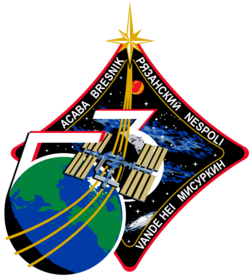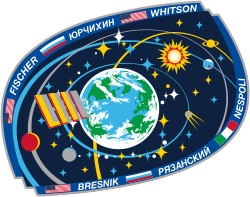Randolph Bresnik
| Randolph Bresnik | |
|---|---|
 | |
| Land | USA |
| Organisation | NASA |
| ausgewählt | 6. Mai 2004 (19. NASA-Gruppe) |
| Einsätze | 2 Raumflüge |
| Start des ersten Raumflugs | 16. November 2009 |
| Landung des letzten Raumflugs | 14. Dezember 2017 |
| Zeit im Weltraum | 149d 12h 12min |
| EVA-Einsätze | 4 |
| EVA-Gesamtdauer | 25h 11min |
| Raumflüge | |
| |
Randolph James „Randy“ Bresnik (* 11. September 1967 in Fort Knox, Kentucky, USA) ist ein US-amerikanischer Astronaut.
Ausbildung
Bresnik erhielt 1989 einen Bachelor in Mathematik von der Militärakademie „The Citadel“ in South Carolina und 2002 einen Master in Luftfahrttechnik von der University of Tennessee in Knoxville.
Im Mai trat Bresnik ins United States Marine Corps ein. Nach seiner Ausbildung wurde er unter anderem als Testpilot und als Pilotenausbilder eingesetzt. Auch im Zweiten Golfkrieg flog er mehrere Kampfeinsätze.
Astronautentätigkeit
Im Mai 2004 wurde Bresnik als Pilot mit der 19. NASA-Gruppe zum Astronautenanwärter ausgewählt. Im Februar 2006 schloss er sein Astronautentraining ab.
Bresnik wurde im September 2008 für die Space-Shuttle-Mission STS-129 nominiert.[1] Er startete am 16. November 2009 mit der Raumfähre Atlantis zur Internationalen Raumstation (ISS).
Am 28. Juli 2017 startete Bresnik zu seinem zweiten Raumflug. Zusammen mit Sergei Rjasanski und Paolo Nespoli flog er im Raumschiff Sojus MS-05 zur ISS. Dort arbeitete er zunächst als Bordingenieur der Expedition 52. Am 2. September übernahm er das Kommando der Expedition 53. Am 14. Dezember 2017 erfolgte der Rückflug zur Erde.
Privates
Bresniks Tochter Abigail Mae wurde am 21. November 2009 geboren, während er sich gerade im All aufhielt. Dies war nach der Geburt von Mike Finckes Tochter im Juni 2004 das zweite Mal, dass ein NASA-Astronaut zur Zeit der Geburt seines Kindes im Weltall war. Bresnik und seine Frau Rebecca haben einen Sohn, den sie im Jahr zuvor als Säugling aus der Ukraine adoptiert hatten.[2]
Siehe auch
Weblinks
- Randolph Bresnik auf der NASA-Website – Biografie, Bilder und Videos (englisch; PDF)
- Spacefacts-Biographie
Quellen
- ↑ NASA Assigns Crew For Space Shuttle Discovery's STS-129 Mission. NASA, 5. September 2008, archiviert vom (nicht mehr online verfügbar) am 27. Mai 2009; abgerufen am 15. September 2009 (englisch). Info: Der Archivlink wurde automatisch eingesetzt und noch nicht geprüft. Bitte prüfe Original- und Archivlink gemäß Anleitung und entferne dann diesen Hinweis.
- ↑ Orbiting astronaut welcomes daughter. CNN, 22. November 2009, abgerufen am 23. November 2009 (englisch).
| Personendaten | |
|---|---|
| NAME | Bresnik, Randolph |
| ALTERNATIVNAMEN | Bresnik, Randolph James; Bresnik, Randy (Spitzname) |
| KURZBESCHREIBUNG | US-amerikanischer Astronaut |
| GEBURTSDATUM | 11. September 1967 |
| GEBURTSORT | Fort Knox, Kentucky |
Auf dieser Seite verwendete Medien
The Expedition 53 crew insignia
- The International Space Station is our launch pad into the future of human space exploration. Collectively, our world stands at the cusp of incredible developments as a spacefaring species. Onboard the space station we continue to evolve the technologies vital to the sustainment and longevity of humans in the harsh realities of living without gravity or the protection of our atmosphere. These self-sustaining or regenerative technologies continually developed aboard the space station not only improve life here on Earth, but they are essential to human beings existence beyond low-Earth orbit (LEO).
- The space station is the linchpin for this next great phase of development and is instrumental in expanding the use of space, not only as a worldclass science laboratory, but also as a destination for next-generation space vehicles. This journey beyond LEO is depicted in the Expedition 53 patch as we, the crew, will endeavor to accomplish the work that allows future missions to further explore our solar system. This journey will only be accomplished as an international team, represented by our multinational crew as well as by the many countries depicted on the globe.
- The myriad of stars represent the untold number of passionate and supremely dedicated people that endeavor across the planet daily to make the space station the amazing vehicle it is as well as prepare us for the next great steps forward in space exploration.
The Expedition 52 crew insignia
- Our planet is shown surrounded by an imaginary constellation shaped like a house, depicting the theme of the patch: “The Earth is our home.” It is our precious cradle, to be preserved for all future generations. The house of stars just touches the Moon, acknowledging the first steps we have already taken there, while Mars is not far away, just beyond the International Space Station, symbolized by the Roman numeral “LII,” signifying the expedition number.
- The planets Saturn and Jupiter, seen orbiting farther away, symbolize humanity’s exploration of deeper space, which will begin soon. A small Sputnik is seen circling the Earth on the same orbit with the ISS, bridging the beginning of our cosmic quest till now: Expedition 52 will launch in 2017, sixty years after that first satellite.
- Two groups of crew names signify the pair of Soyuz vehicles that will launch the astronauts of Expedition 52 to the Station.
STS-129 patch, embroidery artwork version
- For STS-129 the sun shines brightly on the International Space Station (ISS) above and the United States below representing the bright future of U.S. human spaceflight. The contiguous U.S., Rocky Mountains, and Great Desert Southwest are clearly visible on the earth below encompassing all the NASA centers and the homes of the many dedicated people that work to make our Space Program possible. The integrated shapes of the patch signifying the two Express Logistics Carriers that will be delivered by STS-129 providing valuable equipment ensuring the longevity of the ISS. The Space Shuttle is vividly silhouetted by the sun highlighting how brightly the Orbiters have performed as a workhorse for the U.S. Space Program over the past 3 decades. The Space Shuttle ascends on the Astronaut symbol portrayed by the Red, White and Blue swoosh bounded by the gold halo. This symbol is worn with pride by this U.S. crew representing their country on STS-129. The names of the crew members are denoted on the outer band of the patch. As STS-129 launches, the Space Shuttle is in its twilight years. This fact is juxtaposed by the 13 stars on the patch which are symbolic of our children who are the future. The Moon and Mars feature predominantly to represent just how close humankind is to reaching further exploration of those heavenly bodies and how the current Space Shuttle and ISS missions are laying the essential ground work for those future endeavors.
Astronaut Randolph J. (Randy) Bresnik, mission specialist



